Search
- Page Path
-
- HOME
- Search
- Original Article
- Allergy
- Association between dyslipidemia and asthma in children: a systematic review and multicenter cohort study using a common data model
- Ji Eun Lim, Hye Min Kim, Ju Hee Kim, Hey Sung Baek, Man Yong Han
- Clin Exp Pediatr. 2023;66(8):357-365. Published online June 14, 2023
-
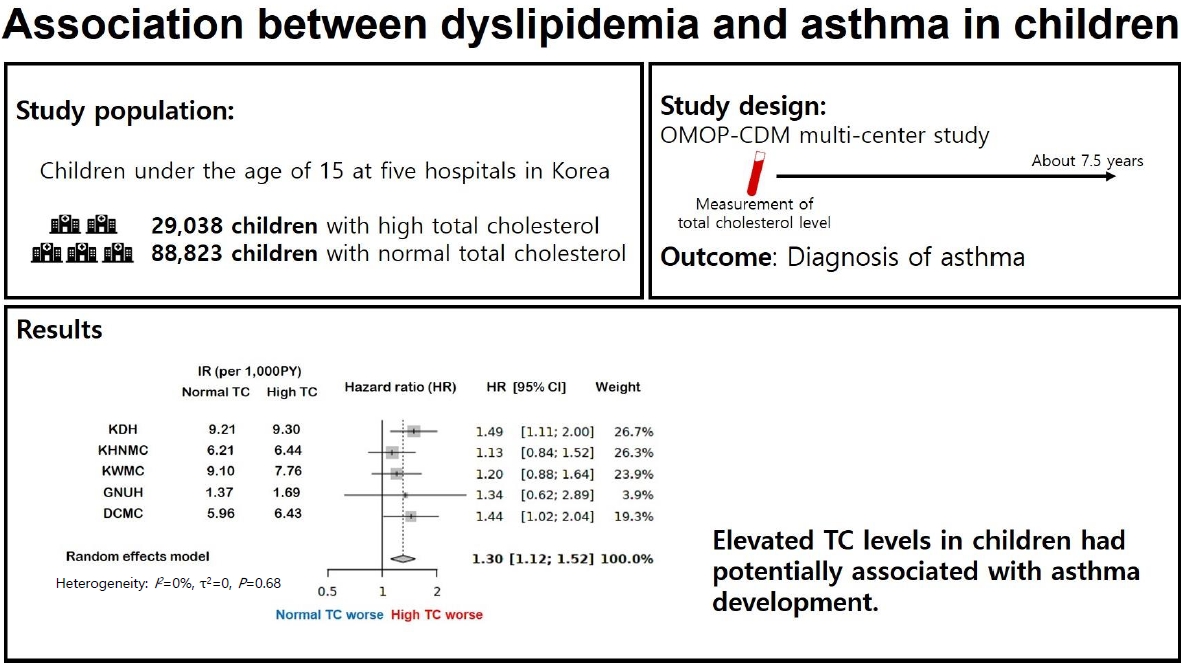
Question: Is dyslipidemia a risk factor for asthma in children?
Finding: This was a comprehensive systematic review and retrospective multicenter study of the association between dyslipidemia and asthma in children. In a multicenter cohort analysis using the Observational Medical Outcomes Partnership Common Data Model, elevated total cholesterol levels were associated with increased risk of asthma development.
Meaning: These findings suggest an association between dyslipidemia and asthma in children.
- Neonatology (Perinatology)
- Mediation effect of cord blood cortisol levels between maternal prepregnancy body mass index and birth weight: a hospital-based cross-sectional study
- Nisanth Selvam, Jayashree K, Prasanna Mithra
- Clin Exp Pediatr. 2022;65(10):500-506. Published online July 29, 2022
-
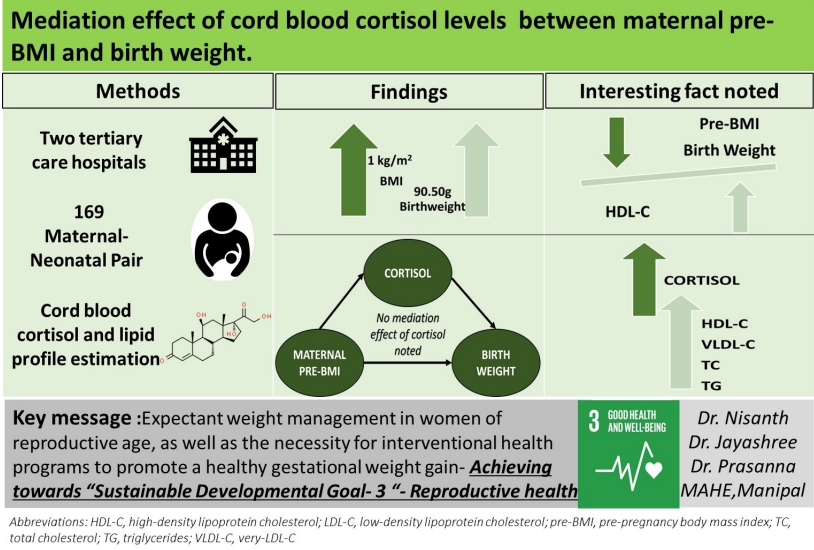
Question: What is the association between cord blood cortisol and maternal weight, birth weight, and cord blood lipid profile?
Finding: Cord blood cortisol levels did not influence the relationship between maternal weight changes or birth weight. Maternal weight changes, birth weight, and cortisol levels altered the cord blood lipid profile.
Meaning: Our findings may aid United Nations Sustainable Development Goal 3 (Good Health and Well-Being) achievement by 2030.
- Review Article
- General Pediatrics
- A new perspective on cholesterol in pediatric health: association of vitamin D metabolism, respiratory diseases, and mental health problems
- Jeana Hong
- Clin Exp Pediatr. 2022;65(2):65-72. Published online December 9, 2021
-
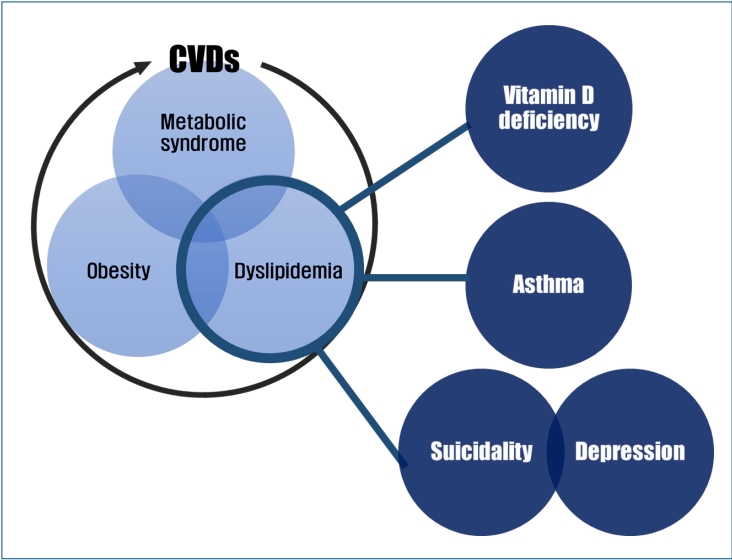
∙ Pediatric dyslipidemia is associated with several health problems besides cardiovascular diseases.
∙ There is a direct association between pediatric dyslipidemia and low serum vitamin D levels, asthma, and mental health problems regardless of body mass index.
∙ More large-scale nationally representative studies are needed to establish the appropriate cutoff points for the definition of dyslipidemia that is a prerequisite for further epidemiological studies in the Korean pediatric population.
- Original Article
- Cardiology
- Early myocardial functional abnormalities in primary dyslipidemia: clinical and echocardiographic observations in young children from a highly consanguineous population
- Nehal M. El-koofy, Aya M. Fattouh, Areef Ramadan, Mohamed A. Elmonem, Dina H. Hamed
- Clin Exp Pediatr. 2022;65(8):410-416. Published online December 8, 2021
-
In children with primary dyslipidemia, functional myocardial abnormalities can occur at young age, including diastolic functional impairment of both ventricles and narrowing of the aortic valve and the sinus of Valsalva. Echocardiographic evaluations of high-risk children may be as important as biochemical evaluations.
- Guideline
- Endocrinology
- 2017 Clinical practice guidelines for dyslipidemia of Korean children and adolescents
- Jung Sub Lim, Eun Young Kim, Jae Hyun Kim, Jae-Ho Yoo, Kyung Hee Yi, Hyun Wook Chae, Jin-Ho Choi, Ji Young Kim, Il Tae Hwang; the Committee of Dyslipidemia of Korean Children and Adolescents on behalf of Korean Society of Pediatric Endocrinology (KSPE)
- Clin Exp Pediatr. 2020;63(12):454-462. Published online November 25, 2020
-

Question: How are children and adolescents with dyslipidemia treated and managed in Korea?
Finding: 2017 guidelines recommend to measure nonfasting non-HDL-C as a screening test and introduce new diet methods: Cardiovascular Health Integrated Lifestyle Diet (CHILD)-1, CHILD-2-low-density lipoprotein cholesterol, and CHILD-2-triglyceride. Statin is the only drug approved in children older than 10 years.
Meaning: New clinical practice guidelines for treating and managing dyslipidemia of Korean children and adolescents are provided.
- Original Article
- Endocrinology
- Influence of subclinical hypothyroidism on metabolic parameters in obese children and adolescents
- Ozlem Kara
- Clin Exp Pediatr. 2020;63(3):110-114. Published online March 6, 2020
-
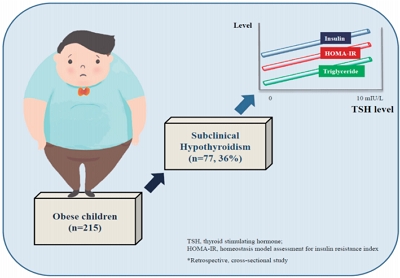
Question: Does subclinical hypothyroidism in obese children and adolescents affect metabolic parameters?
Finding: Insulin, HOMA-IR, and TG levels were higher and the HDL-C level was lower in patients with SH.
Meaning: A clear association is observed between SH, and insulin resistance and dyslipidemia in obese children. It can be said that the TSH may be evaluated as a metabolic risk factor in obese patients.
- Lipid accumulation product is a predictor of nonalcoholic fatty liver disease in childhood obesity
- Bahar Özcabı, Salih Demirhan, Mesut Akyol, Hatice Öztürkmen Akay, Ayla Güven
- Clin Exp Pediatr. 2019;62(12):450-455. Published online October 28, 2019
-
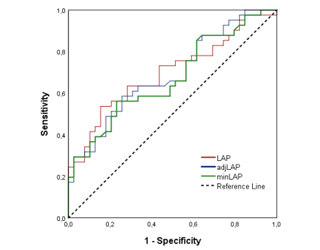
Background: Lipid accumulation product (LAP) is associated with the presence and severity of nonalcoholic fatty liver disease (NAFLD) in adults.
Purpose: Here we evaluated the ability of LAP to predict NAFLD in obese children. Methods: Eighty obese children (38 girls; age 6–18 years) were included. Anthropometric measurements and biochemical values were obtained from the patients’ medical records. LAP was calculated as [waist...
- Impact of lifestyle factors on trends in lipid profiles among Korean adolescents: the Korea National Health and Nutrition Examination Surveys study, 1998 and 2010
- Shin-Hye Kim, Young-Hwan Song, Sangshin Park, Mi-Jung Park
- Clin Exp Pediatr. 2016;59(2):65-73. Published online February 29, 2016
-
Purpose Only a few studies have explored nationwide trends in lipid profiles among Asian adolescents. We aimed to assess trends in lipid profiles and the associated lifestyle factors among Korean children.
Methods We analyzed data for 2,094 adolescents who were aged 10–18 years and had participated in the Korea National Health and Nutrition Examination Surveys in 1998 and 2010.
Results During 1998–2010, the prevalence of...
- Case Report
- A case of mucolipidosis II presenting with prenatal skeletal dysplasia and severe secondary hyperparathyroidism at birth
- Ju Sun Heo, Ka Young Choi, Se Hyoung Sohn, Curie Kim, Yoon Joo Kim, Seung Han Shin, Jae Myung Lee, Juyoung Lee, Jin A Sohn, Byung Chan Lim, Jin A Lee, Chang Won Choi, Ee-Kyung Kim, Han-Suk Kim, Beyong Il Kim, Jung-Hwan Choi
- Clin Exp Pediatr. 2012;55(11):438-444. Published online November 23, 2012
-
Mucolipidosis II (ML II) or inclusion cell disease (I-cell disease) is a rarely occurring autosomal recessive lysosomal enzyme-targeting disease. This disease is usually found to occur in individuals aged between 6 and 12 months, with a clinical phenotype resembling that of Hurler syndrome and radiological findings resembling those of dysostosis multiplex. However, we encountered a rare case of an infant...
- Magnetic resonance imaging and spectroscopic analysis in 5 cases of Pelizaeus-Merzbacher disease: metabolic abnormalities as diagnostic tools
- Eun Lee, Mi-Sun Yum, Hae-Won Choi, Han-Wook Yoo, Su Jeong You, Eun-Hye Lee, Tae-Sung Ko
- Clin Exp Pediatr. 2012;55(10):397-402. Published online October 29, 2012
-
Pelizaeus-Merzbacher disease (PMD) is a rare, X-linked recessive disorder characterized by dysmyelination in the central nervous system. PMD results from deletion, mutation, or duplication of the proteolipid protein gene (
PLP1 ) located at Xq22, leading to the failure of axon myelination by oligodendrocytes in the central nervous system. PMD may be suspected when there are clinical manifestations such as nystagmus, developmental...
- Original Article
- A study of the development of macrovascular complications and factors related to these complications in young adults with childhood/adolescence-onset type 1 diabetes mellitus
- Min Jae Kang, Joo Hwa Kim, Hye Rim Chung, Young Ah Lee, Choong Ho Shin, Sei Won Yang, You Yeh Kim, Seon Mi Jin, Chung Il Noh
- Clin Exp Pediatr. 2009;52(2):220-226. Published online February 15, 2009
-
Purpose : Macrovascular complications are the main cause of mortality in type 1 diabetes mellitus (T1DM). The purpose of this study was to clarify the presence of early vascular changes and to assess the risk factors of macrovascular complications in young adults with T1DM diagnosed in childhood and adolescence. Methods : Seventy-two patients (23.9¡¾2.4 years) with T1DM diagnosed before 18 years... -
- Prevalence of obesity, hypertension, and hyperlipidemia in Gunpo children of low economic status
- Kyung Hee Yi
- Clin Exp Pediatr. 2008;51(12):1310-1314. Published online December 15, 2008
-
Purpose : This study aimed to assess the prevalence of obesity, hypertension, and hyperlipidemia in children from low-income families in Gunpo and to evaluate whether economic status affects the prevalence of obesity. Methods : Between October 2007 and March 2008, 341 children (167 girls and 174 boys; age, 6 to 13 years) were enrolled in this study. All these children came... -
- The effects of high-dose intravenous immunoglobulin on plasma protein and lipid levels in the patients with Kawasaki disease
- Keun Young Lee, Dong-Un Kim, Hyun Seung Lee, Pil Sang Jang, Young-Hoon Kim, Jin Tack Kim, Hyun Hee Kim, Kyung-Yil Lee, Joon-Sung Lee
- Clin Exp Pediatr. 2006;49(12):1348-1353. Published online December 15, 2006
-
Purpose : The reticuloendothelial system is composed of sinusoidal capillaries, through which even large protein molecules are freely movable between plasma and interstitial space, including the lymphatic system. Therefore, high-dose intravenous immunoglobulin (IVIG) would cause a redistribution of proteins between two compartments. To investigate this hypothesis, we measured plasma protein and lipid levels in patients with Kawasaki disease before and... -
- The evaluation of risk for aspiration using lipid-laden macrophage index in infants with bronchiolitis
- Ji Yeon Koh, Hee Kang, Ju Young Chung, Tae Hee Han, Chang Keun Kim
- Clin Exp Pediatr. 2006;49(7):763-768. Published online July 15, 2006
-
Purpose : We investigated the risk of aspiration using the lipid-laden macrophage index(LLMI) from laryngeal lavages in infants with bronchiolitis. Methods : Laryngeal lavages from 22 infants with acute bronchiolitis caused by respiratory syncytial virus(RSV) were evaluated during the acute stage. Repeat studies were performed at 3 to 4 weeks after the initial study(remission stage). Lavage cell counts and differentials were... -
- The Prevalence of Obesity, Serum Lipid Levels and Age at Menarche in Adolescent Female Athletes
- Bo Young Kang, Yang Kyong Kim, Young Jin Hong, Byong Kwan Son, Kyung Ja Chang, Soon Ki Kim
- Clin Exp Pediatr. 2005;48(1):21-26. Published online January 15, 2005
-
Purpose : The aim of this study is to find the prevalence of obesity, the serum lipid levels and the age at menarche in adolescent female athletes and to examine the effects of exercise in adolescent stage. Methods : With a questionnaire regarding their age at menarche, physical measurement, body fat, and blood samples of the serum lipid levels to... -
- Serum Lipids of School Children and Adolescence in Urban and Rural Area
- Dong Han Shin, Hee Sun Lee, Kee Hyoung Lee, Baik-Lin Eun, Chae Seung Lim, Young Chang Tockgo
- Clin Exp Pediatr. 2004;47(12):1273-1280. Published online December 15, 2004
-
Purposes : A cross-sectional study on serum lipids in school children and adolescents was carried out in two different areas in 2002. We studied to determine of the difference in lipids level of children between urban and rural areas and changes of cholesterol levels compared to those of early- 1990 studies. Methods : A cross-sectional study on serum lipids in school... -
- Case Report
- A Case of Acute Pancreatitis in a Neuroblastoma Patient after Retinoic Acid Therapy
- Yoo Jin Jeong, Yeon Kyong Seo, Heung Sik Kim, Hee Jung Lee
- Clin Exp Pediatr. 2003;46(11):1128-1130. Published online November 15, 2003
-
Retinoic acid has been used successfully as a differentiating agent in acute promyelocytic leukemia and neuroblastoma. However, some adverse effects have been recognized, such as headaches, dry skin and retinoic acid syndrome, a life threatening acute cardiorespiratory disorder. Acute pancreatitis with hyperlipidemia has rarely been reported. We experienced a case of acute pancreatitis with hyperlipidemia in a neuroblastoma patient after... -
- Original Article
- Umbilical Cord Arterial Concentrations of Isoprostane(8-iso-PGF2α) in Newborn Infants
- Kun Song Lee, Yoon Hee Ji, Young Pyo Chang
- Clin Exp Pediatr. 2003;46(9):865-870. Published online September 15, 2003
-
Purpose : We measured the umbilical cord arterial concentrations of isoprostane(8-iso-PGF2α) and intended to decide whether the umbilical cord arterial concentrations of isoprostane could be used as a useful parameter for lipid peroxidation in newborn infants. Methods : The isoprostane and malondialdehyde(MDA) concentrations of the umbilical cord were measured by enzyme immunoassay and TBARS(thiobarbituric acid reactive substance) assay in 33... -
- Alteration of Biochemical Profiles after High-Dose Intravenous Immunoglobulin Administration in Kawasaki Disease
- Ji-Won Lee, Kyung-Yil Lee
- Clin Exp Pediatr. 2003;46(8):817-820. Published online August 15, 2003
-
Purpose : Intravenous immunoglobulin(IVIG) has been used as an immunomodulatory treatment for several immune-mediated diseases. The early effect of high-dose IVIG on biochemical profiles including lipids and proteins was evaluated in patients with Kawasaki disease(KD). Methods : Twelve children with KD(nine boys) were treated with IVIG of 2 g/kg over 12 hours. Serial sera were collected from the patients four times... -
- Relationship between Body Fat Distribution and Metabolic Risk Factors in Adolescents
- Dal Hyun Kim, Tae Jung Seong, Young Jin Hong, Byong Kwan Son, Soon Ki Kim
- Clin Exp Pediatr. 2003;46(4):326-334. Published online April 15, 2003
-
Purpose : The objectives of this study were to estimate the prevalence of obesity in adolescents; to study the association between obesity, blood pressure, and dyslipidemia; and to evaluate the superiority of waist circumference to waist/hip ratio(WHR) in central obesity. Methods : We selected 1382 adolescents(M : F=690 : 692) aged from 11 to 18 years(mean age; boys 15.0, girls 15.4)... -
- Effective Screening Test for Obesity in Obese Adolescents and the Correlation Among Obesity Index, Body Mass Index and Serum Lipid Profile
- Tae Jung Sung, Dal Hyun Kim, Young Jin Hong, Byong Kwan Son, Kyung Ja Chang, Jun Young Park, Soon Ki Kim
- Clin Exp Pediatr. 2003;46(3):217-223. Published online March 15, 2003
-
Purpose : Every year, there is a remarkable increase in the prevalence of children with excess body fat. The aim of this study is to find a useful screening method in assessing adolescent, obesity and to specify the predictable risk factors that are related to adult cardiovascular disease according to BMI and obesity index. Methods : From July to November in... -
- Relationship between Gb3 Expression and Cytotoxicity of Shiga-like Toxin I
- Suk-Hwan Lim, Gi-Young Kim, Hyung-Chun Kim, Young-Hee Kim, Yong-Hae Son, Yang-Hyo Oh, Yeong-Min Park
- Clin Exp Pediatr. 2003;46(2):143-153. Published online February 15, 2003
-
Purpose : Infection with Shiga-like toxin (SLT)-producing Escherichia coli, an emerging human pathogen found particularly in young children under 5 years of age, causes a spectrum of illnesses with high morbidity and mortality, ranging from diarrhea to hemorrhagic colitis and hemolytic uremic syndrome. Host mediators play an important role in the pathogenesis of SLT-I toxicity. The experiments described here were... -
- Effects of Insulin Level on Dyslipidemia in Children with Simple Obesity
- Jung Sub Lim, Choong Ho Shin, Sei Won Yang
- Clin Exp Pediatr. 2002;45(6):764-772. Published online June 15, 2002
-
Purpose : Obesity is closely related to insulin resistance, compensatory hyperinsulinemia and dyslipidemia in adults. We identified the effect of obesity measured by BMI and insulin resistance on dyslipidemia in children and adolescents. Methods : The fasting serum insulin, glucose, total cholesterol, triglyceride, HDL- and LDL-cholesterol were measured and insulin resistance(HOMA-IR) was calculated in 35 children with simple obesity(age :... -
- Changes of Body Weight and Lipid Profiles According to Apolipoprotein E Polymorphism in Children with Antiepileptics
- Seung Hee Jang, Eun Kyoung Choi, So Hee Eun, Sun Jun Kim
- Clin Exp Pediatr. 2002;45(1):88-94. Published online January 15, 2002
-
Purpose : Weight changes, especially weight gain, is a side effect of antiepileptics(especially valproate and carbamazepine). This may be sufficiently severe to cause noncompliance or to require the withdrawal of effective treatment. Unfortunately, the exact mechanism of weight change is not illustrated. Several reports and our experiment suggested that weight gain highly correlated with a familial tendency of obesity. The genetic makeup is a... -
- Risk Factors for Fatty Liver in Obese Children
- Ki Won Park, Jong Eun Lee, Kyung Ha Ryu, Kyung Hyo Kim, Young Mi Hong, Gyung Hee Kim, Keun Lee, Jeong Hyun Yoo
- Clin Exp Pediatr. 2001;44(6):669-676. Published online June 15, 2001
-
Purpose : The incidence of obese patients has increased recently in Korea. Obesity is associated with hypertension, hyperlipidemia, insulin resistance, and fatty liver. Since recent investigators have revealed that not only fat accumulation but also fibrosis and nonspecific hepatitis can be found in the livers of obese children, fatty liver is currently considered as an important complication. The purpose of... -
- Serum Lipid Levels and Fatty Acid Metabolism in the Rat with Adriamycin Induced Cardiomyopathy
- Young Mi Hong, Hye Ran Yoon
- Clin Exp Pediatr. 2000;43(11):1480-1487. Published online November 15, 2000
-
Purpose : Adriamycin induced cardiomyopathy is irreversible and may procede to clinical congestive heart failure. Recently, it has been suggested that adriamycin may exert cardiomyopathy due to inhibition of transport across mitochondrial membranes mediated by the carnitine palmitoyltransferase system(CPT I). The effect of adriamycin on fatty acid metabolism according to cumulative dose was not clarified. The purpose of this study... -
- Apolipoprotein E Polymorphism and Plasma Lipid Levels in Obese Children
- Myoung Hee Han, Sun Jun Kim
- Clin Exp Pediatr. 2000;43(5):679-685. Published online May 15, 2000
-
Purpose : The increased prevalence of dyslipoproteinemia in obese children probably contributes to the high risk of cardiovascular disease associated with being overweight. The genetic makeup is possible one of the factors that influence the impact of obesity on lipid metabolism. A relation between apolipoprotein E(Apo E) polymorphism and lipid metabolism has been convincingly demonstrated in large population. The purpose... -
- Lipid Profile Changes in Kawasaki Disease Patients
- Ye-Jhin Lee, Young-Seok Lee, Myung-Chul Hyun, Sang-Bum Lee
- Clin Exp Pediatr. 2000;43(2):216-222. Published online February 15, 2000
-
Purpose : Abnormality in the composition of lipid metabolism is well known to be a main cause of atherosclerosis. Accordingly the abnormality in lipid metabolism after suffering from Kawasaki disease may lead to premature coronary atherosclerosis. The aim of this study is to investigate the abnormalities of lipid metabolism in patients with Kawasaki disease. We studied 67 patients with Kawasaki... -
- Intralipid Infusions Effect on Nutrophil Elastase Level in Newborns
- Sue Jeen Min, Yong Woon Baek, Yong Woon Baek, Yong Woon Baek
- Clin Exp Pediatr. 1999;42(5):666-671. Published online May 15, 1999
-
Purpose : Parenteral nutrition is given to infants who tempararily cannot take oral feeding adequately. A lipid emulsion is added to the parenteral to supply essential fatty acids. In neonatal sepsis, elastase from azuropilic granules of the neutrophils is released and rapidly bound to α1- Proteinase Inhibitor(α1-PI). The lipid emulsion has been noted to markedly inhibit chemotaxis of neutrophils, so... -
- Diagnostic Sensitivity in Predicting Hyperlipidemia by Bioelectrical Impedance Analysis in Obese Children
- Ji Ah Jung, Hyun Mi Kim,, Young Mi Hong, Gyoung Hee Kim
- Clin Exp Pediatr. 1998;41(11):1583-1589. Published online November 15, 1998
-
Purpose : Childhood obesity is currently on the rise. The complications of childhood obesity are depression, adult obesity, hypertension, diabetes, hyperlipidemia, coronary artery disease and fatty liver. Therefore, accurate diagnosis of obesity is important. The purpose of this study was to assess diagnostic sensitivity to predict hypelipidemia by bioelectrical impedance analysis(BI) in obese children. Methods : One hundred fifteen healthy... -
-

-
-

-

-
Impact Factor4.2
-
6.52022CiteScore92nd percentilePowered by







